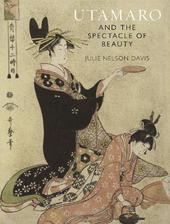
|
Utamaro and the Spectacle of Beauty: Revised and Expanded Second Edition
Paperback / softback
Main Details
| Title |
Utamaro and the Spectacle of Beauty: Revised and Expanded Second Edition
|
| Authors and Contributors |
By (author) Julie Nelson Davis
|
| Physical Properties |
| Format:Paperback / softback | | Pages:296 | | Dimensions(mm): Height 250,Width 190 |
|
| Category/Genre | Oriental art
Prints and printmaking |
|---|
| ISBN/Barcode |
9781789142358
|
| Classifications | Dewey:769.92 |
|---|
| Audience | |
|---|
| Edition |
Second Edition, Revised and Expanded Edi
|
| Illustrations |
114 illustrations, 66 in colour
|
|
Publishing Details |
| Publisher |
Reaktion Books
|
| Imprint |
Reaktion Books
|
| Publication Date |
18 January 2021 |
| Publication Country |
United Kingdom
|
Description
Japanese artist Kitagawa Utamaro (1753-1806) was one of the most influential artists working in the genre of ukiyo-e, 'pictures of the floating world,' in late eighteenth-century Japan, and was widely appreciated for his prints of beautiful women. In 1804, at the height of his success, Utamaro published a set of prints related to a banned historical novel. The prints, titled Hideyoshi and his Five Concubines, depicted the military ruler Toyotomi Hideyoshi's wife and concubines, and consequently, he was accused of insulting Hideyoshi's dignity. Utamaro was sentenced to be handcuffed for fifty days and is thought to have been briefly imprisoned. According to some sources, the experience crushed him emotionally and ended his career as an artist. In this new expanded edition, Julie Nelson Davis draws on a wide range of period sources, makes a close study of selected print sets, and reinterprets Utamaro in the context of his times. Reconstructing the place of the ukiyo-e artist within the commercial print market, she demonstrates how Utamaro's images participated in a larger spectacle of beauty in the city of Edo (present-day Tokyo).
Author Biography
Julie Nelson Davis is Associate Professor of East Asian Art in the Department of the History of Art at the University of Pennsylvania.
Reviews"By offering [a] new approach to the constructions of identity, to the roles of gender, sexuality and celebrity in the Edo period, Davis here makes a significant contribution to the field in showing us the constructed nature of the spectacle of beauty . . . her publishers have done her proud. Reaktion Books are always beautifully designed and this one, with its full-color illustrations from all the Utamaro series, its art paper and its elegant binding is one of the best."-- "Japan Times, on the previous edition" "Handsomely produced and copiously illustrated. . . . Davis has written a book that skillfully synthesizes a broad range of historical, cultural and artistic data that underscore the degree to which the conventional understanding of the floating world artist is an illusion constructed with the collusion of the viewer. General reader and scholars alike will appreciate her careful analyses of the multi-layered visual and verbal meanings of Utamaro's most familiar print series."-- "Print Quarterly, on the previous edition" "This beautifully illustrated volume presents an engaging argument which will be of interest to a readership with prior knowledge of Edo art history."-- "Art Book, on the previous edition" "Davis provides a succinct and credible overview of Utamaro's career, one devoid of the romanticized drama found in most treatments of this artist . . . Drawing on the research of Edo culture specialists, Davis treats the reader to a series of interesting and informative essays on such topics as the publishing industry, the Tenmei-era gesaku community, the history of the Yoshiwara and its protocols, the pseudoscience of physiognomy, and the Kansei reforms."-- "Monumenta Nipponica, on the previous edition" "Utamaro and the Spectacle of Beauty makes a significant contribution to the field of ukiyo-e studies by aptly showing that past readings of Utamaro as one au fait with the life of women has limited our understanding of the complexity of social factors that led to such a construct. By approaching her reading of the Utamaro style as the concept of a publishing industry geared to catering to the needs of the market, Davis opens up a broader reading of his work that reveals much about cultural and societal attitudes, particularly those related to the perception of women in the male-dominated Edo society."-- "Japanese Studies, on the previous edition"
|